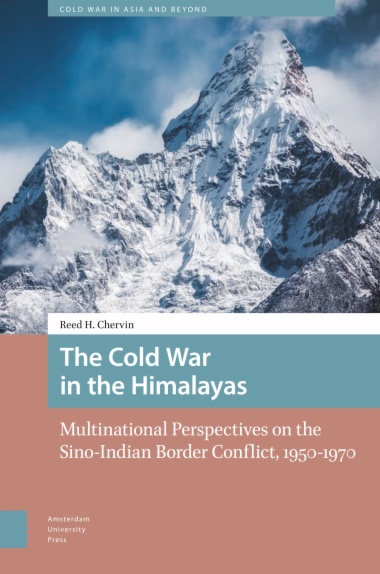Extensive in scope and drawing on newly available evidence from multinational archives, this book reconsiders Sino-Indian border issues during the middle Cold War using multiple established analytical frameworks. It demonstrates how key countries perceived and engaged with the border conflict by aiding the two main participants morally and materially. Before, during, and after the 1962 Sino-Indian border war, multinational political actors pursued their foreign policy goals (e.g., trade, security, and prestige) concerning the frontier, and often tried to destabilize spheres of influence and bolster alliances. Therefore, this contest signified a variation of the Anglo-Russian Great Game in Asia during the nineteenth century, and the theater of operations encompassed not only the border itself, but also the Himalayan kingdoms, Tibet, and Burma. A reevaluation of the border conflict between India and China is necessary given current, ongoing clashes at their still unresolved border as well as the fact that these two countries now possess enhanced technology and weapons.
- Cover
- Table of Contents
- Acknowledgements
- Note on Chinese Romanization and Translations
- Introduction
- I. The 1962 War
- 1 The 1962 War and Domestic Reactions in China and India
- 2 Immediate International Fallout
- II. Antebellum
- 3 Chinese Views and Policies Toward the Southern Frontier, 1950–1962
- 4 Indian Views and Policies Toward the Northern Frontier, 1950–1962
- 5 Views and Policies of the Anglophone West Toward the Sino-Indian Frontier, 1950–1962
- III. Postbellum
- 6 Chinese Post-War Overtures Abroad, 1962–1970
- 7 India’s “New” Frontier Policies and Foreign Assistance, 1962–1970
- 8 Western Policies Toward South and Southeast Asia, Plus Pakistan’s Response, 1962–1970
- Conclusions
- Selected Bibliography
- Index
- List of Figures
- Figure 0.1. Map of the western sector of the Sino-Indian border.
- Source: Steven A. Hoffmann, India and the China Crisis (Berkeley: University of California Press, 1990), 11.
- Figure 0.2. Map attached to the 1914 Simla Accord.
- Source: Map to Illustrate Article 9 of the Simla Convention, 1914, (London: The Geographical Journal, September 1960) [Map] Retrieved from the RGS-IBG Collections, Royal Geographical Society.
- Figure 0.3. Eastern sector of the Sino-Indian border.
- Source: The Sino-Indian War of 1962, eds. Das Gupta and Lüthi, 5.
- Figure 0.4. Depiction of Indian and Chinese spheres of influence.
- Source: Garver, Protracted Contest, 15.
- Figure 1.1. Chinese operations in the western sector.
- Source: Cheng and Wortzel, “PLA Operational Principles and Limited War,” in Chinese Warfighting, 185.
- Figure 1.2. Chinese operations in the eastern sector.
- Source: John W. Garver, China’s Quest: The History of the Foreign Relations of the People’s Republic of China, First edition (New York: Oxford University Press, 2016), 180.
- Figure 1.3. National Defence Fund advertisement.
- Source: The Hindu, November 12, 1962.
- Figure 1.4. Sikh soldier guarding a mountain pass.
- Source: Life magazine, found in 64-5065, box 73, 63-3057 to 63-3774, RG 306 PS-D, Records of the United States Information Agency (RUSIA), National Archives and Records Administration (NARA).
- Figure 1.5. �Indian troops using a cable to cross a river in the North-East Frontier Agency.
- Source: India RSC, found in 63-948, box 69, 63-723 to 63-1154, RG 306 PS-D, RUSIA, NARA.
- Figure 1.6. Chinese troops scaling a snowbank.
- Source: Renmin ribao, October 21, 1962.
- Figure 1.7. Chinese troops on the lookout for Indian planes.
- Source: Renmin ribao, October 21, 1962.
- Figure 1.8. The Hindu political cartoon I.
- Source: The Hindu, November 23, 1962.
- Figure 1.9. The Hindu political cartoon II.
- Source: The Hindu, November 4, 1962.
- Figure 1.10. The Indian Nation political cartoon.
- Source: The Indian Nation, November 7, 1962.
- Figure 2.1. U.S. estimate of Chinese logistical requirements for attacking India.
- Source: “Logistic Requirements and Capabilities of Communist China to Conduct Military Campaigns against India,” November 18, 1962, HN01220, DNSA, GWU.
- Figure 2.2. �The Nassau aid commitment to India as of May 1963 [numbers listed in millions of U.S. dollars; adjusted for inflation figures (in billions of dollars) are in parentheses].
- Source: “President Radhakrishnan Visit to Washington, June 3–5, 1963 Background Paper: Western Military Assistance Summary,” India subjects Radhakrishnan Briefing Book, June 3–5, 1963, box 112, NSF, PPK, JFKL.
- Figure 2.3. U.S. map of the Chinese air threat to northeast India.
- Source: “U.S.-U.K. Estimate of Chinese Communist Capabilities for Attacking India through Burmese Territory,” August 14, 1963, Defense Affairs, DEF 19 Military Assistance—Basic Data, box 3, Records Relating to Indian Political Affairs, 1964–1966, RG 59, D
- Figure 2.4. U.S. map of Chinese air capabilities.
- Source: “Communist Chinese Air Capability Against India,” J.I.C. /1901/62, December 4, 1962, box 536, HP, LoC.
- Figure 3.1. �Flight paths from Taipei and locations in Southeast Asia to Cona for transporting war materiel and contact personnel to Tibetan rebels.
- Source: “Dui Xizang kangbao yundong kongtou zhiyuan zhi yanjiu,” 002-080102-00096-016, AH.
- Figure 4.1. Sketch depicting a potential Chinese thrust through West Bengal.
- Source: “Problem of Indian Defence,” November 7, 1959, 15-3(21) Acc.-392, NAM.
- Figure 4.2. �Map depicting the Indian frontier, including—going from west to east—the Ladakh, Tibet, Nepal, Sikkim, Kalimpong, Bhutan, and the Sino-Indian-Burmese trijunction.
- Source: Delhi Hindustan Standard, August 31, 1959, found in 15-3(21) Acc.-392, NAM.
- Figure 8.1. �U.S. estimate of Chinese troop concentrations near the Sino-Indian border, March 18, 1963.
- Source: “U.S.-U.K. Estimate of the Chinese Communist Ground Threat to India from Tibet and Sinkiang,” August 14, 1963, Defense Affairs, DEF 19 Military Assistance—Basic Data, box 3, Records Relating to Indian Political Affairs 1964–1966, RG 59, DSCF, NARA
- Figure 8.2. Proposed cruise schedule of the U.S. Concord Squadron.
- Source: “Proposed Cruise Schedule of Concord Squadron; April 13–May 22, 1965,” November 25, 1964, Defense Affairs, DEF 1 Indian Ocean Task Force, box 1, Records Relating to Indian Political Affairs 1964–1966, RG 59, DSCF, NARA.

